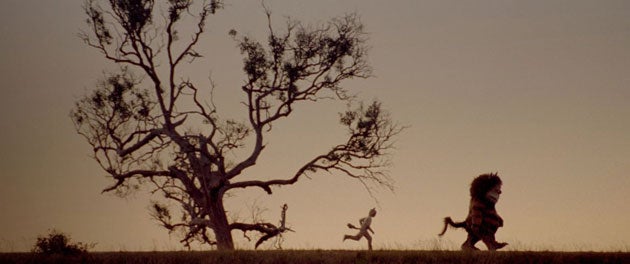Where the Wild Things Are (PG)
Spike Jonze rummages in his inner child for this take on Sendak's storybook, but it's the grown-ups who will find it fascinating

I'm not convinced that any film-makers can genuinely lay claim to being children at heart – other than Tim Burton and Quentin Tarantino (and one of them you really wish would grow up). Children's films by directors known for adult work tend to smack of their makers dressing up in a borrowed inner-child costume. That's certainly the sense you get from Spike Jonze's take on Where the Wild Things Are – which is, after all, a dressing-up story. In Maurice Sendak's much-loved picture book, an unruly boy runs riot in his wolf suit and is sent to his room, which instantly turns into a jungle: he sails away to the land of the Wild Things, tames these rampaging chimerae and becomes their king. It's a wonderfully rich fable of children's frustration, of confronting fears, of taming but also accepting the raging id. And it's only 338 words long.
With co-writer Dave Eggers, Spike Jonze, who directed the inspired Being John Malkovich, has turned the book into a nearly two-hour film. Jonze's most daring move is to set Sendak's imaginings in a frame of everyday mundanity. The film's opening establishes its hero's lonely existence: nine-year-old Max (a lively, candid actor named Max Records) plays alone, largely ignored by his teenage sister and only half paid attention by his divorced mother (Catherine Keener). Max gets furious, bites, then runs off to rage in a nearby wood.
The magic follows naturally: Max climbs into a waiting boat and crosses an ocean to a dark island with fires burning at its peak. There, in the film's eeriest sequence, he sees the Wild Things destroy their own nest-like homes by hurling themselves at them. Besotted with destruction, Max joins in and is crowned their king.
Then the film goes strangely dead, leaving us with little to engage us except the strangeness of its forest demons. Variously resembling a goat, a bull, a budgie with ears, these lumbering creatures are like giant walking carnival effigies. Jonze uses huge puppets rather than opting for the usual digital effects (although CGI serves to animate their facial expressions). Thus the creatures pack real physical weight: as they crash through the woods, you believe not just in their gargantuan cuddliness but also in their dangerous physicality. For all their cartoonishness, these are remarkably real-seeming creations, with their matted hair and crusty-soled feet; you imagine they smell pretty beastly, too.
Some are almost cute: Carol, voiced by James Gandolfini, has a big, cat-like face that looms benignly as he sniffs Max. Melancholy eyes make the Things seem less like animals than ancient children, carrying a terrible weight of sorrow. But Jonze, Eggers and a voice cast that includes Lauren Ambrose and Forest Whitaker don't succeed in turning the Things into characters. Each beast gets a voice and an incongruous name – Judith, Ira, Douglas – but the only one with real personality is Alexander the goat, portrayed as a shy nebbish. They talk like grouchy, neurotic old people, the script sometimes occasionally slipping, like Wes Anderson's Fantastic Mr Fox, into smarty-pants psychobabble.
There's some pleasure to be had from the wanton wrecking that flies in the face of the eco-wisdom now routinely programmed into children's films: the Things gratuitously punch holes in trees, smash cliffs with a single jump, even bring owls hurtling down from the sky by hurling rocks. When they all pile into a big, hairy heap to doze off together, it feels as if Max has fallen in with a gang of elderly Hell's Angels.
Frustratingly – you might also say, bravely – there is no plot to speak of. Max rallies the creatures to build a fortress, then they run around some more, bash a few more things, bicker and sulk. There are no outsiders, or even significant events: it's simply about playmates getting on, falling out, then having to admit their fears and weaknesses. Ultimately the film seems to be about a child learning to handle his own depression when he realises that grown-ups get it even worse. Even the book's jubilant Wild Rumpus comes across like a session of primal-scream therapy.
But the lack of spectacle is precisely what makes this an intriguing, if not satisfying, film for grown-ups. Jonze and cameraman Lance Acord create a distinctive look entirely at odds with the shiny intensity of contemporary children's cinema – real rather than hyper-real, and persuasively close to the texture of dream. The palette is muted, the textures grainy, the landscapes not so much fantastic as just strange, and somewhat desolate.
Where the Wild Things Are is unashamedly an art movie in a poetic-realism vein, and by far the weirdest film supposedly made for children since Robert Altman tried his hand at Popeye. Younger children, I suspect, will be terrified, and I doubt that older ones will care for it much. Child psychologists, on the other hand, will be fascinated.
Where the Wild Things Are, Spike Jonze, 101 mins, PG
Join our commenting forum
Join thought-provoking conversations, follow other Independent readers and see their replies
Comments